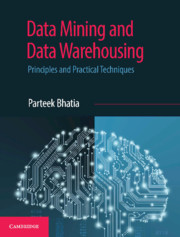Book contents
- Frontmatter
- Dedication
- Contents
- List of Figures
- List of Tables
- Preface
- Acknowledgments
- 1 Beginning with Machine Learning
- 2 Introduction to Data Mining
- 3 Beginning with Weka and R Language
- 4 Data Preprocessing
- 5 Classification
- 6 Implementing Classification in Weka and R
- 7 Cluster Analysis
- 8 Implementing Clustering with Weka and R
- 9 Association Mining
- 10 Implementing Association Mining with Weka and R
- 11 Web Mining and Search Engines
- 12 Data Warehouse
- 13 Data Warehouse Schema
- 14 Online Analytical Processing
- 15 Big Data and NoSQL
- Index
- Colour Plates
4 - Data Preprocessing
Published online by Cambridge University Press: 26 April 2019
- Frontmatter
- Dedication
- Contents
- List of Figures
- List of Tables
- Preface
- Acknowledgments
- 1 Beginning with Machine Learning
- 2 Introduction to Data Mining
- 3 Beginning with Weka and R Language
- 4 Data Preprocessing
- 5 Classification
- 6 Implementing Classification in Weka and R
- 7 Cluster Analysis
- 8 Implementing Clustering with Weka and R
- 9 Association Mining
- 10 Implementing Association Mining with Weka and R
- 11 Web Mining and Search Engines
- 12 Data Warehouse
- 13 Data Warehouse Schema
- 14 Online Analytical Processing
- 15 Big Data and NoSQL
- Index
- Colour Plates
Summary
Chapter Objectives
✓ To understand the need for data preprocessing.
✓ To identify different phases of data preprocessing such as data cleaning, data integration, data transformation and data reduction
Need for Data Preprocessing
For any data analyst, one of the most important concerns is ‘Data’. In fact, the representation and quality of data which is being used for carrying out an analysis is the first and foremost concern to be addressed by any analyst. In the context of data mining and machine learning, ‘Garbage in, Garbage out’, is a popular saying while working with large quantities of data.
Commonly, we end up having lot of noisy data; as an example, income: -400 i.e. negative income. Sometimes, we may have unrealistic and impossible combinations of data, for example, in a record, Gender-Male may be entered as Pregnant-Yes. Obviously absurd! because males do not get pregnant. We also suffer due to missing values and other data anomalies. Analyzing such sets of data, that have not been screened before analysis can cause misleading results. Hence, data preprocessing is the first step for any data mining process.
Data preprocessing is a data mining technique that involves transformation of raw data into an understandable format, because real world data can often be incomplete, inconsistent or even erroneous in nature. Data preprocessing resolves such issues. Data preprocessing ensures that further data mining process are free from errors. It is a prerequisite preparation for data mining, it prepares raw data for the core processes.
The University Management System Example
For any University Management System, a correct set of information about their students or vendors is of utmost importance in order to contact them. Hence, accurate and up to date student information is always maintained by a university. Correspondence sent to wrong address would, for instance, lead to a bad impression about the respective university.
Millions of Customer Support Centres across the globe also maintain correct and consistent data about their customers. Imagine a case where a call centre executive is not able to identify the client or customer that he is handling, through his phone number. Such scenarios suggest how reputation is at stake when it comes to accuracy of data. But, on the other hand obtaining the correct details of students or customers is a very challenging task.
- Type
- Chapter
- Information
- Data Mining and Data WarehousingPrinciples and Practical Techniques, pp. 55 - 64Publisher: Cambridge University PressPrint publication year: 2019

